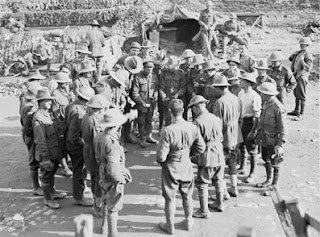M. G. Heuston, who served with 2/12th Commando Squadron during the Second World War, ran a two-up game during this time. In the following account, he explains how the game was played.
To stage a game required a quiet spot, with a flat area big enough for an 18- or 20-foot radius circle clearly etched in the dirt. This was done with twine, with two loops, one at each end, using bayonets to mark the circle.
The
boxer or manager of the game sat with his coins, kips, string and money tray in the place where he could view the whole ring clearly.The ringie, who was usually a friend who volunteered, ran the centre of the ring.
When the game was about to commence, there would be a number of people around and outside the circle. The boxer would call and ask for a spinner, who would have the right to select whether he wanted to play two-up or swy (also know as “sudden death”).
The kip would then hold two or three pennies, depending on the game. (Some of the kips were smooth, with no ridges in the wood. It was illegal for anyone to use their fingers in the game I ran, so we had “lips” on the various kips for right or left handed spinners who were not adept at using the smooth kip. The plastic used on some of the kips I used was taken from crashed planes on the side of the airstrip at Morotai.)
The spinner would then select the coins that he wished to use (Queens, new or old, baldies, George V, etc.).
The head side on each penny was polished and the tail side was left dark, so that it was obvious to anyone around the ring whether the coin fell as head or tail.
It was the ringie’s job to ensure that the coins were tossed at least 10 feet into the air, and that they spun well and were not “feathered” in any way. If the coins didn’t’t satisfy these specifications in his opinion, he would call ” foul toss ” and catch one of the coins.
The ringie would place the coins tail up on the kip. The call “come in spinner ” was made from the box. The spinner then tossed the coins. All pennies (whether two or three) had to fall within the circle. If one fell outside or on the circle, it was declared void by the ringie. The spinner then had another turn.
While this was happening, side bets were allowed around the ring. There were two distinct types of betting:
betting that the spinner would toss heads or tails
other tail betters would bet 3/1 that heads would not be tossed twice.
In all cases, the bets were held in front of the
The spinner had the right to continue spinning while ever he tossed heads. If he tossed three heads in a row, the boxer would take his commission out of the centre (the guts) and the spinner had the right to toss the kip (and take the money) or continue spinning. The change of spinner went clockwise around the ring.
If the spinner got to six heads in a row, the boxer took another commission, and the game continued until the spinner tossed tails or tossed the kip.
In some places, a multitude of currencies was used. It was the boxer’s call which stated the exchange rate for any or all currency. In addition, he could exchange currencies.
At the end of the game, if the tail betters had had a good day, they would
As the game was held more often than once a week, you found that some of your customers went broke. The boxer usually lent them enough for cigarettes and a beer until next pay.
A game would run for up to three or four hours.
Glossary of terms :
Boxer: the game owner.
Ringie: the supervisor in the ring.
Kip: the flat board used to throw the coins.
Spinner: the player who throws or tosses the pennies.
coins available for the spinner to choose. (The Queen is Queen Victoria; the Baldie is Edward VII.)
Toss the kip: to pull out of the game and take the stake.
Tail-betters: the name for those who bet only on tails. In most cases, they chose not to spin the coins.
Sling: a tip given to the boxer




